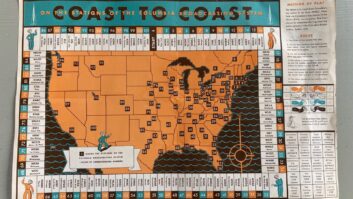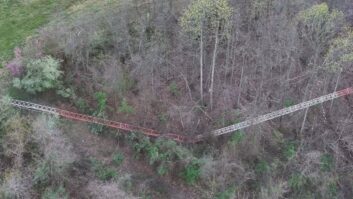
CINCINNATI — Bearcast Radio has been the sound of the University of Cincinnati since the turn of century, playing music from the College Music Journal Top 200 charts and offering diverse talk and sports programming.
Like most university radio stations, Bearcast Radio is staffed mostly by student DJs, with high turnover each semester. Unlike most university stations, Bearcast Radio is online-only, accessible at www.bearcastradio.com and through the Shoutcast website and mobile app.
Live experience
The station typically features live personalities from 10 a.m. to 2 a.m. during the academic year, with automation otherwise supporting playout. Recently, there has been a thirst to incorporate automation into the live DJ experience at Bearcast Radio, as well as a dire need to simplify the on-air experience through a modern console. A visit to the Harris Broadcast booth at the NAB Show proved fruitful on both accounts.
Harris Broadcast is known for its PR&E brand of consoles, but an unusual demonstration initially captured our attention. Called “Desktop Radio,” the complete package included its PR&E Oasis on-air console and a WideOrbit automation system, with direct USB integration for audio and logic; as well as three microphones, monitors and other key equipment — notably its World Feed Panel, a breakout box with multiple I/O options for source equipment.
The Oasis console was alone an important upgrade. The studio had long used a Studer On-Air 2000 console, a real workhorse that offered technology quite advanced for its time. However, at six feet in length, its footprint was massive. And with 13 years on its touchscreens and on-air components, it was beginning to fail.
The Oasis consumes far less space, but its foremost benefit is the learning curve and simplicity — important given the consistent student turnover. There is no better example than the two large, horizontal vu meters. These are instrumental in training students quickly how to monitor and comprehend audio levels, and make on-the-fly adjustments to position and fade. By comparison, students had a difficult time reading the Studer meters (which were off to the right side), and often the on-air levels were too low or peaking with distortion.
Operationally, Harris Broadcast did a good job of including what broadcasters need for on-air operations, and not confusing matters with unnecessary features. The A/B switching for each fader accommodates simple expansion, and its built-in mix-minus capability will allow Bearcast Radio to expand live talk capability in the future. For now, the talk operation is fairly simple, with a single phone line for live callers and remotes, and other standard on-air sources (mics, CD players, etc.).
The automation system and the World Feed Panel are the two most interesting Oasis tie-ins. The direct USB connection pulls four channels of audio into the console, allowing students to operate in “live assist” mode with automation instead of fiddling constantly with CDs. Students can pot up four faders and automatically switch from one channel to the next for seamless on-air broadcasts.
Alternatively, the World Feed Panel enables Bearcast Radio to bring more excitement to broadcasts through live or unusual sources. This is essentially a 3RU interface panel that accommodates temporary connection of portable devices into the Oasis, such as an iPod or laptop. It accommodates all common connections, like RCA and XLR, as well as an active USB interface.
Additionally, this panel can accept high-quality audio from an Oasis output and feed it to a video camera, allowing a simple capture for a talk show with integrated video and audio. This eliminates the need to mic the talent individually, or connect shotgun mics to separate mixers and cameras. It is helpful for occasional specialty shows, such as interviews with the university president.
Moving forward, Bearcast Radio expects to add a second Oasis console to its production studio, where students can train without interrupting on-air operations — while also working to fully explore the power that the Desktop Radio solution brings to the table.
For information, contact Brian Clifford at Harris Broadcast in Ohio at (513) 459-3714 or visit www.harrisbroadcast.com.










